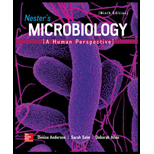
Nester's Microbiology: A Human Perspective
9th Edition
ISBN: 9781259709999
Author: Denise G. Anderson Lecturer, Sarah Salm, Deborah Allen
Publisher: McGraw-Hill Education
expand_more
expand_more
format_list_bulleted
Concept explainers
Question
Chapter 4, Problem 1MC
Summary Introduction
Introduction:
Generation time is an important phenomenon to be studied in population biology. An average time taken between two consecutive generations in the lineages of a population is defined as generation time. It can predict the number of population after a particular time interval.
Expert Solution & Answer
Want to see the full answer?
Check out a sample textbook solution
Students have asked these similar questions
Please draw in the missing answer, thank you
Please fill in all blank questions, Thank you
please fill in missing parts , thank you
Chapter 4 Solutions
Nester's Microbiology: A Human Perspective
Ch. 4 - Describe a detrimental and a beneficial effect of...Ch. 4 - Define a pure culture.Ch. 4 - Prob. 3SACh. 4 - Explain how the environment of a colony differs...Ch. 4 - Prob. 5SACh. 4 - Why would botulism be a concern with canned foods?Ch. 4 - Explain why O2-containing atmospheres kill some...Ch. 4 - Explain why photoautotrophs are primary producers.Ch. 4 - Distinguish between a selective medium and a...Ch. 4 - Prob. 10SA
Ch. 4 - Prob. 1MCCh. 4 - Compared with their growth in the laboratory,...Ch. 4 -
3. Cells are most sensitive to penicillin during...Ch. 4 - Which best describes the intestinal tract? a) An...Ch. 4 - E. coli, a facultative anaerobe, is grown for 24...Ch. 4 - The generation time of a bacterium was measured at...Ch. 4 - Which of the following is false? a)E. coli grows...Ch. 4 -
8. If the pH indicator were left out of MacConkey...Ch. 4 -
9. A soil sample is placed in liquid and the...Ch. 4 -
10. If the concentration of E. coli in a broth is...Ch. 4 -
1. You are a microbiologist working for a...Ch. 4 - High-performance boat manufacturers know that...Ch. 4 - This figure shows a growth curve plotted on a...Ch. 4 - Prob. 2CT
Knowledge Booster
Learn more about
Need a deep-dive on the concept behind this application? Look no further. Learn more about this topic, biology and related others by exploring similar questions and additional content below.Similar questions
- please draw in the answers, thank youarrow_forwarda. On this first grid, assume that the DNA and RNA templates are read left to right. DNA DNA mRNA codon tRNA anticodon polypeptide _strand strand C с A T G A U G C A TRP b. Now do this AGAIN assuming that the DNA and RNA templates are read right to left. DNA DNA strand strand C mRNA codon tRNA anticodon polypeptide 0 A T G A U G с A TRParrow_forwardplease answer all question below with the following answer choice, thank you!arrow_forward
- please draw in the answeres, thank youarrow_forwardA) What is being shown here?B) What is indicated by the RED arrow?C) What is indicated by the BLUE arrow?arrow_forwardPlease identify the curve shown below. What does this curve represent? Please identify A, B, C, D, and E (the orange oval). What is occurring in these regions?arrow_forward
- Please identify the test shown here. 1) What is the test? 2) What does the test indicate? How is it performed? What is CX? 3) Why might the test be performed in a clinical setting? GEN CZ CX CPZ PTZ CACarrow_forwardDetermine how much ATP would a cell produce when using fermentation of a 50 mM glucose solution?arrow_forwardDetermine how much ATP would a cell produce when using aerobic respiration of a 7 mM glucose solution?arrow_forward
- Determine how much ATP would a cell produce when using aerobic respiration to degrade one small protein molecule into 12 molecules of malic acid, how many ATP would that cell make? Malic acid is an intermediate in the Krebs cycle. Assume there is no other carbon source and no acetyl-CoA.arrow_forwardIdentify each of the major endocrine glandsarrow_forwardCome up with a few questions and answers for umbrella species, keystone species, redunant species, and aquatic keystone speciesarrow_forward
arrow_back_ios
SEE MORE QUESTIONS
arrow_forward_ios
Recommended textbooks for you
 Principles Of Radiographic Imaging: An Art And A ...Health & NutritionISBN:9781337711067Author:Richard R. Carlton, Arlene M. Adler, Vesna BalacPublisher:Cengage Learning
Principles Of Radiographic Imaging: An Art And A ...Health & NutritionISBN:9781337711067Author:Richard R. Carlton, Arlene M. Adler, Vesna BalacPublisher:Cengage Learning Cardiopulmonary Anatomy & PhysiologyBiologyISBN:9781337794909Author:Des Jardins, Terry.Publisher:Cengage Learning,
Cardiopulmonary Anatomy & PhysiologyBiologyISBN:9781337794909Author:Des Jardins, Terry.Publisher:Cengage Learning,





Principles Of Radiographic Imaging: An Art And A ...
Health & Nutrition
ISBN:9781337711067
Author:Richard R. Carlton, Arlene M. Adler, Vesna Balac
Publisher:Cengage Learning

Cardiopulmonary Anatomy & Physiology
Biology
ISBN:9781337794909
Author:Des Jardins, Terry.
Publisher:Cengage Learning,